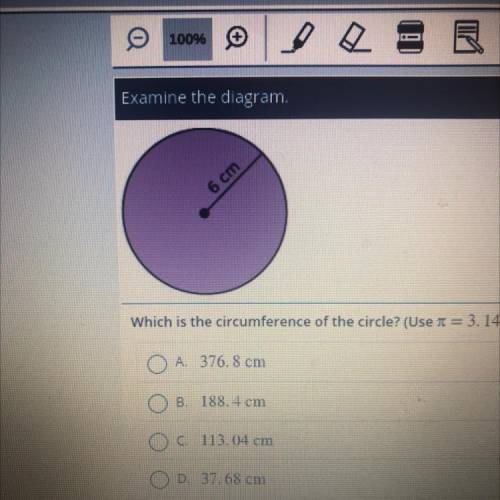Examine the diagram.
6 cm
Which is the circumference of the circle? (Use = 3.14)
A. 37...

Mathematics, 04.05.2021 21:00 khush77
Examine the diagram.
6 cm
Which is the circumference of the circle? (Use = 3.14)
A. 376.8 cm
B. 188.4 cm
C. 113.04 cm
D. 37.68 cm
E. 18.84 cm
No links please


Answers: 1


Other questions on the subject: Mathematics


Mathematics, 22.06.2019 00:20, ashtonviceoxd21i
Submarines control how much they float or sink in the ocean by changing the volume of air and water contained in large ballast tanks. when the tanks are completely full of water, the submarine increases its overall mass and sinks down to the bottom. when the tanks are completely full of air, the submarine reduces its overall mass and floats to the surface. depending on the density of the seawater surrounding the submarine, it will pump seawater in or out of the tanks in order to achieve the same overall density as the sea water and float neutrally in the water. the volume of the submarine never changes. when the tanks are completely full of water, a submarine with a volume of 7.8\times10^3\text{ m}^37.8×10 3 m 3 7, point, 8, times, 10, start superscript, 3, end superscript, space, m, start superscript, 3, end superscript has a total mass of 8\times10^6\text{ kg}8×10 6 kg8, times, 10, start superscript, 6, end superscript, space, k, g. the density of the seawater is 10^3\text{ kg/m}^310 3 kg/m 3 10, start superscript, 3, end superscript, space, k, g, slash, m, start superscript, 3, end superscript. to make that submarine float neutrally, and neither float nor sink in the ocean, what volume of water does that submarine need to subtract from its tanks?
Answers: 1

Mathematics, 22.06.2019 00:50, NayeliNoel
E. which of the following is not a possible probability? a. 25/100 b. 1.25 c. 1 d. 0
Answers: 1

Mathematics, 22.06.2019 02:30, misk980
Atrain traveled for 1.5 hours to the first station, stopped for 30 minutes, then traveled for 4 hours to the final station where it stopped for 1 hour. the total distance traveled is a function of time. which graph most accurately represents this scenario? a graph is shown with the x-axis labeled time (in hours) and the y-axis labeled total distance (in miles). the line begins at the origin and moves upward for 1.5 hours. the line then continues upward at a slow rate until 2 hours. from 2 to 6 hours, the line continues quickly upward. from 6 to 7 hours, it moves downward until it touches the x-axis a graph is shown with the axis labeled time (in hours) and the y axis labeled total distance (in miles). a line is shown beginning at the origin. the line moves upward until 1.5 hours, then is a horizontal line until 2 hours. the line moves quickly upward again until 6 hours, and then is horizontal until 7 hours a graph is shown with the axis labeled time (in hours) and the y-axis labeled total distance (in miles). the line begins at the y-axis where y equals 125. it is horizontal until 1.5 hours, then moves downward until 2 hours where it touches the x-axis. the line moves upward until 6 hours and then moves downward until 7 hours where it touches the x-axis a graph is shown with the axis labeled time (in hours) and the y-axis labeled total distance (in miles). the line begins at y equals 125 and is horizontal for 1.5 hours. the line moves downward until 2 hours, then back up until 5.5 hours. the line is horizontal from 5.5 to 7 hours
Answers: 1
You know the right answer?
Questions in other subjects:


English, 05.05.2020 16:48

Mathematics, 05.05.2020 16:48


Mathematics, 05.05.2020 16:48

Mathematics, 05.05.2020 16:48






